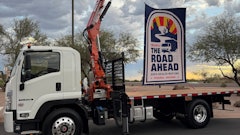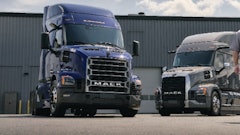
As the construction industry has waited for convincing economic recovery, the average age of heavy-duty construction trucks has increased by almost three years. The coincidence of new-truck prices rising to cover the cost of compliance with the Environmental Protection Agency's 2010 diesel emissions regulations has many construction truck owners debating if they should replace aging trucks with new ones or rebuild what they have.
"Owning and operating costs of 2010 technology can appear to be higher than 2007 and earlier technology on the surface," says Steve Jenkins, director of North American Engine Sales for Navistar. "The balance that buyers have to evaluate is the additional cost involved in the new equipment compared to the lost revenue of downtime resulting from operating older equipment. While a low bid can be a deciding factor in the construction industry, downtime for an entire project due to older equipment can result in lost future business for customers who haven't upgraded.
"Operating costs for 2010 engines can be similar or better than pre-emission engines," Jenkins continues. "Manufacturers have worked to improve fuel economy and are now reaching levels not seen with earlier trucks. Maintenance costs for heavies are mostly similar to earlier engines as pushing out oil drains has been a staple of the long-haul segment for quite some time. We at Navistar have been able to use some of this technology to improve drain so that will actually allow for lowered costs. Filter technology has improved as well, to the extent that on some engines, fuel filter change intervals are now every other oil drain."
"Primary factors that drive overall cost of ownership include fuel and maintenance, no matter what the emission level," says TJ Reed, director of product marketing at Freightliner. Both have been addressed in trucks with 2010 technology.
"EPA 2010 BlueTec SCR vehicles versus EPA 2007 vehicles have seen a fuel economy improvement of approximately 5%," says Reed, reporting an improvement that is typical among truck makers. And the strategy for diesel-particulate-filter regeneration in Freightliner vocational trucks improved with EPA 2010 engines, "So parked regens on jobsites are minimal, if at all, further adding to operating efficiency and performance. Except for the minor addition of a diesel-exhaust-fluid (DEF) filter for EPA 2010BlueTec SCR that requires periodic, routine replacement, maintenance intervals have remained the same."
Mack Trucks is seeing similar fuel economy gains. "Two areas that stand out [in field experience with 2010 engines] so far are that the fuel economy is exactly what we had predicted and the dosing rate of the DEF we had presumed at approximately 3% is much closer to 2.2% -- another operating improvement," says Dave McKenna, director of powertrain sales and marketing, Mack Trucks.
There are other changes with newer technology engines that also impact the cost of operation. "Diesel truck engine manufacturers now typically recommend oil drain intervals based on fuel economy," notes Jenkins. "This is a change impacting customers that have historically used fixed mileage or hour intervals to maintain their diesel engines."
Reliability considerations
"Each operation is different, but we have documented customer reports supporting that the reliability of the Mack ClearTech engines are better than the EPA 2007 iteration," says McKenna. "I think the same could be said for most engine OEMs. Using SCR allows Mack to significantly reduce the amount of exhaust gas we recirculate back through the engine. That alone contributes significantly to the approximately 5% improvement in fuel economy achieved in most duty cycles. Additionally, we now use the NOx rich engine out exhaust to passively oxidize the DPF collected soot – so no more active regeneration events, another plus in the fuel economy column.
"The cost of DEF is also significantly cheaper than we had modeled, so there is additional savings there."
Initial indictors signal that the new technology has addressed many earlier issues, "We are still very early in the life of most engines as of this writing," says McKenna, "But comparatively we are seeing much, much less problems with DPF elements and seventh injector issues.
"Much higher engine component operating temperatures, primarily as the result of higher EGR flow rates, have been reduced via SCR," says McKenna. "Better thermal management equals longer engine life. With our Mack ClearTech engines the size, capacity and performance of the cooling system did not change from 2007, so we have much more operating margin to work with and much less overheat issues with high ambient temperatures and high elevations."
Daimler Trucks North America (DTNA) touts the reliability of its BlueTec technology. "Prior to the EPA 2010 introduction, DTNA had 30 million test miles," says Reed. "SCR technology has been running in Europe since 2006 (with the introduction of EuroIV); and there are approximately 390,000 Class 6 to Class 8 vehicles on the road today with SCR (in the United States and Canada). We have many trucks approaching or past 750,000 miles, one of which we recently performed a tear down on and were impressed by lack of wear. Finally, the B50 life [the duration at which 50% of the engine population is expected to fail] of the Detroit engines was extended to 1 million miles (Detroit DD13) and 1.2 million miles (Detroit DD15 and Detroit DD16)."
It is also important to note that age does affect equipment reliability. "New vehicles provide a measure of predictability," says Reed, "Especially if coupled with extended warranties, as this allows operators to better calculate their costs without needing to account for unplanned repair costs associated with older equipment."
Options to extend life
Some contractors have turned to rebuilding with remanufactured parts to solve their immediate truck needs. In certain circumstances this approach can make sense.
"At Mack our Re-Mack program offers a full array of remanufactured major powertrain components that come with warranties," says McKenna. "This can prolong the life of a vocational truck for a few years."
But choosing between a new truck and extending the life of an older model is not as simple as comparing purchase prices.
When it comes to deciding on whether to replace or rebuild existing technology, vocational customers should consider that they may lose out on some technical advancements, such as Detroit Virtual Technician, SmartPlex multiplex electrical system, extended oil drain intervals, fuel efficiency, driveline enhancements, etc. – all which contribute to a more productive operation," says Betsy Ballard, director of product development and growth, Detroit Reman.
"Relying on remanufactured parts to lower the total cost of truck ownership is not a new concept," says Ballard. "All major fleets and independent owner operators now assume that replacement parts will be reman or a mix in most cases, and are often unpleasantly surprised if they're not."
But make sure you know the difference between a remanufactured part and a rebuilt part.
"If contractors want to ensure they get an OEM-quality part to extend the life of their truck, they need to understand that it's important to select a genuine remanufactured part versus a rebuilt or repaired part," says Ballard. "Taking a chance on a less expensive repaired part or a part supplied from someone that doesn't guarantee a return to the factory specification is risking a more expensive repair down the road."
Even then, extending truck life is not guaranteed.
"Each customer and application is different," notes McKenna. "However, with a good, and I do mean good, preventative maintenance program the life of a Mack truck can be extended considerably. Engines today are much more robust than engines of years ago. It wasn't that long ago that bottom end main and connecting rod bearings were replaced at 150,000 miles. This is just not required any longer. Don't skimp on the engine oil lube, as that is the cheapest insurance you can take out on a modern diesel engine."
Make sure you calculate the true costs before rebuilding equipment. "While remanufactured product may be a solution for some customers, the cost of rebuilding equipment must be balanced against the cost of new technology," says Jenkins. "Some customers believe that rebuilding equipment is a lower cost solution than purchasing new technology and this may be true in some cases. But unless a customer has an adequate facility and the associated expertise, rebuilding equipment can come with risk."
Weight these risks before you proceed. "There are limited opportunities to recover labor costs with remanufactured components and, in some cases, limited or no warranty on the parts themselves," says Jenkins. "Also, a remanufactured component does not address the components bolted onto it; not the sensors and wiring harness that link it all together. So while the cost stream may be lowered for the component installed, it does not slow down the cost stream of the remaining vehicle."




















